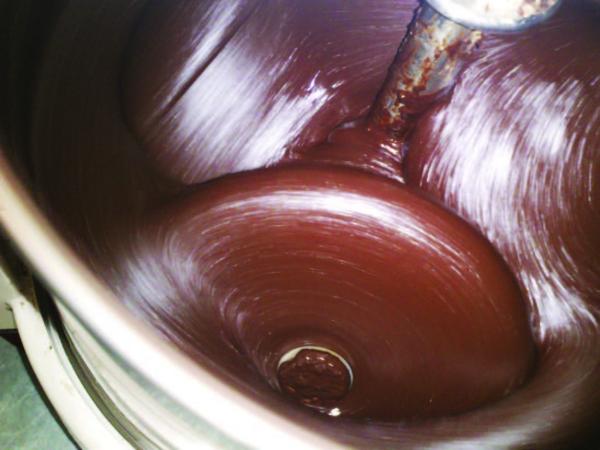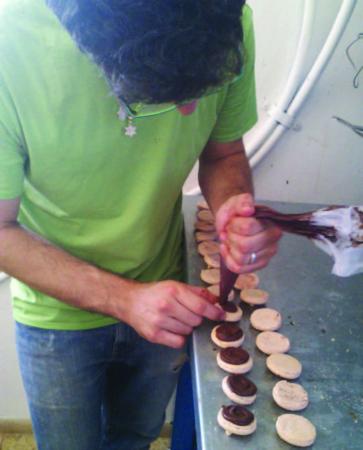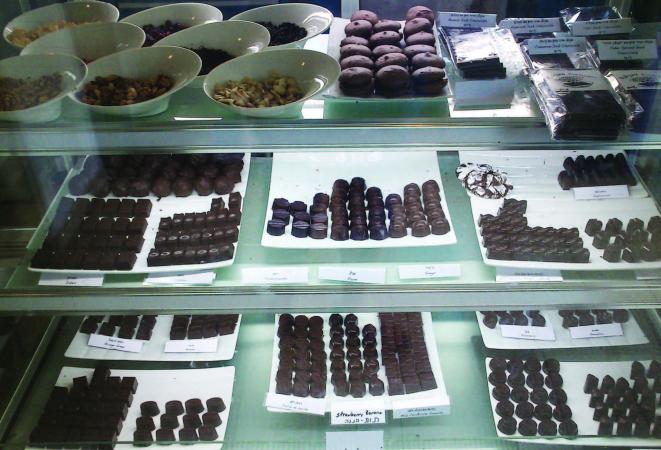From a small shop in the quaint Israeli town of Zichron Yaakov, a young American immigrant with gourmet tastes is fulfilling his chocolate-coated dream. And visitors are always welcome to watch him at his craft.
by Justin Fine
Thinking back to my childhood, the first time I can remember saying, “Mommy, I want to be a....” was when I said I wanted to a chef. After years of watching mom, when I finally made something on my own I proceeded to make cookies using salt instead of sugar. While devastated I was not deterred, and I continued to cook throughout
my childhood.
When I arrived at university in New York and had a chance to cook for myself, I began to realize just how much
I loved both cooking and making people happy through my food. Soon after, I decided to attend a culinary school’s Pastry Arts program as my “semester abroad.” Going into the program, I knew that I was most looking
forward to the chocolate sections. When they finally arrived, I knew I had found my passion. The taste of different
chocolates, the precision with which chocolate must be manipulated, the artistry of beautifully finished products, and the multitude of potential flavor combinations, all drew me to the medium.
For me, however, there was still something missing. Most chocolatiers around the world buy ready-made chocolate, melt it, and add their fillings or toppings. Coming out of pastry school the idea of opening a chocolate shop was still a dream for the future, but I knew even then that if I were to open a shop, I would make, not buy, my chocolate.
I knew that Mast Brothers Chocolate, a bean-to-bar chocolate company in Brooklyn, New York, was doing much
of the work in which I was interested. After graduating in 2011, I finally had a chance to learn from them in a
six-month internship. I spent the time roasting, winnowing, grinding, tempering, and wrapping chocolate from all over the world. The work was sometimes tedious and often dirty, but, for me, it was always interesting and
enriching.
At the end of my six months I was bored. I enjoyed the chocolate making, but no longer wanted to work with someone else’s recipes or techniques. I still felt that my own shop was a long way in the future, and planned to spend the next few years earning a Master’s Degree in food science.
I was accepted to a Food Engineering program in Israel and made aliyah with my wife in July 2012. Once in Israel, I started to grind chocolate in my kitchen. I gave the chocolates to family and friends, and their reactions made me realize that I was heading in the wrong direction. A food science degree would certainly teach me a lot, but it would have also put me in a lab, working for a large company — a far cry from actually making food for people. I realized that while I still had a lot to learn, I was already able to make people happy with food I created.
Over the next few months, I drafted a business plan, found a space, bought equipment, and opened Xocoatl Chocolate Shop in Zichron Yaakov, where I make and sell chocolate, and serve chocolate drinks to customers who can sit and relax at tables.
At Xocoatl, everything that we can make by hand, we do — and customers are welcome to watch. We grind cocoa beans from Peru and the Dominican Republic to make milk and dark chocolate, as well as dark chocolate with inclusions like cinnamon or chili.
I make micro-batches of chocolate, never grinding more than four kilograms of chocolate at any one time. Such small batches allow me to ensure the highest level of quality control. There are four stages in chocolate making: roasting, winnowing, grinding, and tempering. Making chocolate in little batches allows me the chance to both see and feel each cocoa bean before it is ground and to see each gram of liquid chocolate before it is molded.
The first stage of chocolate making is cleaning and roasting the beans. Since cocoa beans are packaged on a farm, all sorts of natural detritus gets mixed in with the beans. I sort through each batch of beans by hand to take out all of the stones, twigs, leaves, and any other non-chocolate material. As well, all of the broken pieces of cocoa beans or flat cocoa beans need to be removed. These smaller pieces will burn before the full-sized beans have completely roasted, giving the chocolate a smoky and burnt taste.
Once the beans are clean, they are roasted. I use a standard convection oven, but am hoping to find a more traditional roasting oven in the near future. In traditional roasting, the beans are continuously tumbled in order to ensure even heating. With my method, I have to constantly agitate the beans to make sure that they are roasting properly. I use temperatures around 300ºF/150ºC, and roast until the beans crack.
After the beans have completely cooled, they are ready to be winnowed. For chocolate making we only want the inner portion of the cocoa bean, the nib, so I need to separate it from the outer shell. At Xocoatl, this is currently the most laborintensive step. I feed all of the cocoa beans through an industrial juicer, which creates a mixture of the inner and outer portions of the beans. Pouring the mixture very slowly through a small winnower almost completes the separation. My winnower is not perfect, so I sit with the winnowed beans searching for large pieces of shell in order to ensure that the beans are as clean as possible.
Chocolate is then ready to be made. It is at this point that cocoa percentages come into play, and at this point that my chocolate starts to differ from industrial chocolate. Up until now, the difference between my chocolate and industrial chocolate had been based upon the quality of the beans that I use and the care with which I handle each bean. When it comes to actual chocolate recipes, however, there are more substantial differences.
Every chocolate grinder making dark chocolate takes the cleaned beans and sugar, most add vanilla and an emulsifier, and some add inclusions such as chili or hazelnuts. All of these ingredients are added to a conching machine that refines and emulsifies all of the ingredients into liquid chocolate.
Without getting too technical, my chocolate has more chocolate than industrial brands. This, combined with the amount of time that the chocolate grinds — about 16 hours — gives my chocolate a richer, more intense chocolate taste.
Once the chocolate comes out of the grinder, it is ready to be used. There are chocolate grinders who age their chocolate, but I have not found enough of a flavor difference to make it worth aging my chocolate. I add my chocolate to tempering machines — machines that heat, cool, and maintain the chocolate at a specific temperature. This temperature, unique to each chocolate, is crucial in order for chocolate to set properly. When the correct temperature is used the chocolate will look dark and shiny, but it will be dull and grey with the wrong temperature. Using various molds, I then produce pralines and bars to fill my display cases with a wide variety of chocolates for my customers to enjoy.
We use our chocolate to make bars, pralines, and pastries, and our menu is always expanding. Each day is a new adventure; there is always an experiment in the works. I know that there is much left to learn, but seeing people’s eyes light up as they try a new chocolate makes the struggles worth it and the successes much sweeter.
Justin’s website is www.xocoatlzy.co.il
We use our chocolate to make bars, pralines, and pastries, and our menu is always expanding. Each day is a new adventure; there is always an experiment in the works. I know that there is much left to learn, but seeing people’s eyes light up as they try a new chocolate makes the struggles worth it and the successes much sweeter.
Justin’s website is www.xocoatlzy.co.il


